Abstract
Let and denote the family of analytic and normalized functions f in the unit disk , such that the quantity or respectively are lying in the region bounded by the limaçon where . The limaçon of Pascal is a curve that possesses properties which qualify it for the several applications in mathematics, statistics (hypothesis testing problem) but also in mechanics (fluid processing applications, known limaçon technology is employed to extract electrical power from low-grade heat, etc.). In this paper we present some results concerning the behavior of f on the classes or . Some appropriate examples are given.
1. An Analytic Representation of a Limaçon of Pascal
A limaçon, known also as a limaçon of Pascal is a curve that in polar coordinates has the form
where are positive real numbers and . This is also called the limaçon of Pascal. The word “limaçon” comes from the Latin “limax”, meaning “snail”. Converting to Cartesian coordinates the Equation (1) becomes
that has the following parametric form
If , a limaçon is convex, and if has an indentation bounded by two inflection points. If , the limaçon degenerates to a cardioid. If , the limaçon has an inner loop, and when , it is a trisectrix (but not the Maclaurin trisectrix). In Figure 1, we have plotted the limaçon for some different values of a and b.
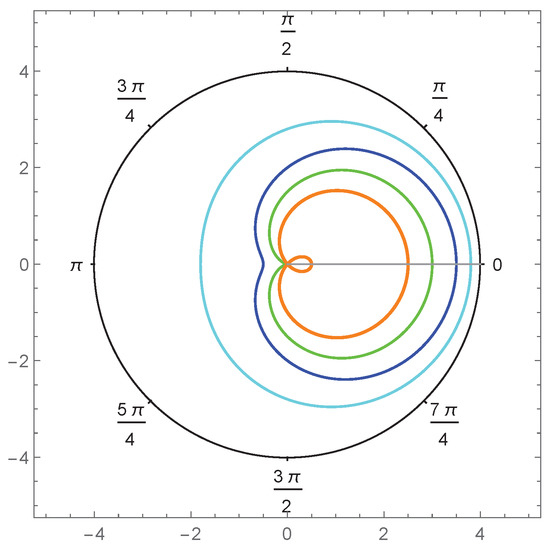
Figure 1.
The image of limaçon with , , and .
An analytic description of a limaçon is given by
that maps the unit disk of the complex plane , onto a domain bounded by a limaçon defined by
where (The Figure 2 shows an example of a image of by the function for different values of s). Indeed, setting with , we obtain
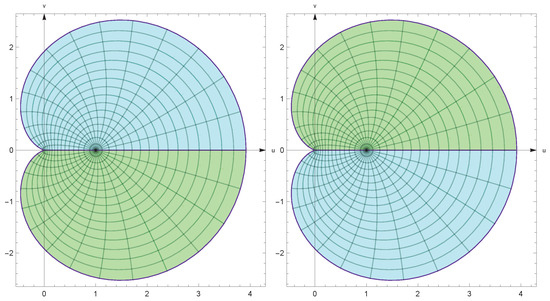
Figure 2.
The image of under .
Let us denote and . Then
Taking a parametrization
we can find that the image of unit circle under is a curve given by
that is the limaçon of Pascal. Furthermore, is an analytic and does not have any poles in since .
It is easy to check that the real and an imaginary part of is bounded. Then and attains its minimum and maximum on . Indeed, by Equation (4) we have
The extremum of is attained at the critical points of the above function, equivalently
which are and the solution of equation , if . Clearly, the minimum value is when and the maximum value is when or . Thus,
For the critical points are and . Thus we have
In addition, from Equation (4) we have
Then if and only if
for . Using an elementary computation we can find then that
The above discussion can be summarized as follows (cf. Figure 3).
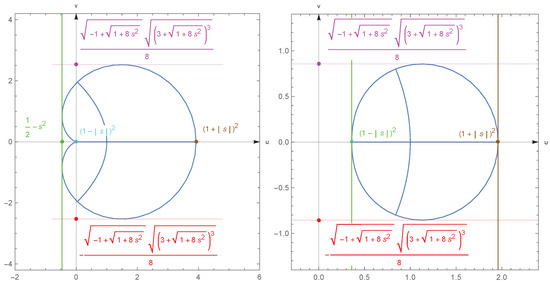
Figure 3.
The max and min value of and .
Theorem 1.
2. Definitions and Preliminaries
Let denote the class of functions of the form:
which are analytic in the open unit disk in the complex plane . The subclass of consisting of all univalent functions f in , is denoted by . A functions is said to belong to the class , called starlike functions of order , if and is said to belong to the class , called convex functions of order , if [1].
The special cases occur for , and then we get the classical classes of starlike and convex univalent functions, denoted and , respectively. Let f and g be analytic in . Then the function f is said to subordinate to g in written by , if there exists a self-map function which is analytic in with and ; , and such that ; . If g is univalent in , then if and only if and [2].
Let the classes and be defined by
and
respectively. Then, it follows from [3] and are the families of univalent function, convex and starlike in one direction, respectively.
Let be the class of analytic univalent function with positive real part in , and with respect to and symmetric with respect to real axis. Ma and Minda [4] gave a unified representation of different subclasses of starlike and convex functions using subordination to some function . The superordinate function is assumed to be univalent. In this way the classes and has been defined
Specialization of the function leads to a number of well-known function classes. For instance, and . yields and . For various choices of and a detailed discussion about classes we refer to the papers [5,6,7,8,9,9].
Definition 1
([10]). Let and the function be univalent in . If the function is analytic in and satisfies the following first-order differential subordination
then is called a solution of the differential subordination.
Lemma 1
([10]). Let q be univalent in , and let Φ be analytic in a domain D containing . If is starlike, then
and q is the best dominant.
This paper aims to investigate the geometric properties of functions in the classes and . In addition, we necessary and sufficient conditions for certain particular members of to be in the classes and .
3. The Classes and and Its Properties
In the following section, we obtain certain inclusion relations and extremal functions for functions in the classes and .
Lemma 2.
Let , and be defined by (2). Then is starlike in , moreover and and for , . In addition, if , then
Proof.
A straightforward calculation shows that satisfies
and
In order to prove the second part of lemma, denote for the function
for some and . It is easy to see that Q attains its minimum at and maximum at , and for attains its minimum at and maximum at . □
From Lemma 2 it can be seen that the smallest disk with center that contains and the largest disk with center at contained in are the following (see Figure 4)

Figure 4.
The image of under , and for .
Taking into account the properties of a function given in Theorem 1 and Lemma 2, we see that for , the function (see also Figure 5). Additionally, those properties allow to formulate the following definition.

Figure 5.
The image of under where .
Definition 2.
By , with , we denote a class of all analytic functions p such that and in , that is
It is clear that is a subfamily of the well-known Carathéodory class of normalized functions in with positive real part.
On the basis of the relationship between subclasses of the Carathéodory class and the notion of classical starlikeness and convexity we also define the following classes.
Definition 3.
Let denote the subfamily of consisting of the functions f, satisfying the condition
and let be a class of analytic functions f such that
From Theorem 1, we obtain that for (and , respectively), it holds
and
where is given in Theorem 1. Geometrically, the condition Equations (11) and (12) mean that the expression or lies in a domain bounded by the limaçon . Since a domain is contained in a right half-plane, we deduce that , resp.) is a proper subset of a starlike functions (convex function , resp.). Further properties of yield:
Additionally,
For a function , we have the equivalence: if and only if . This gives the structural formula for functions in . A function g is in the class if and only if there exists an analytic function , such that
This integral representation supply many examples of functions in class . For , we define the functions in by the relation
namely,
These functions are extremal for several problems in the class (see Figure 6).
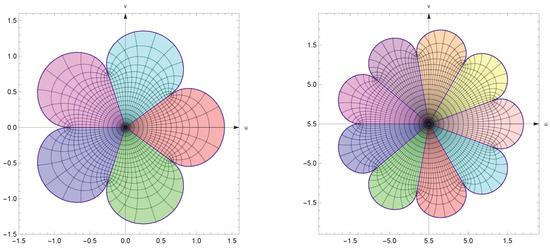
Figure 6.
The image of under for .
For instance, we have
For a function , we have the equivalence: if and only if . This gives the structural formula for functions in . A function h is in the class if and only if there exists an analytic function p with , such that
This above integral representation supply many examples of functions in class . Let , then the functions (see Figure 7)
for some are extremal functions for several problems in the class . For we have
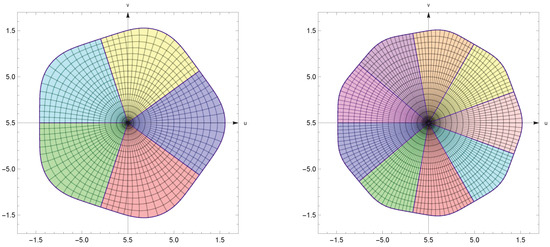
Figure 7.
The image of under for .
From Equation (9), a function is in if and only if
Thus we have the following result.
Proposition 1.
Let . The classes and are nonempty. The following functions are the examples of their members.
- Let with . Then
- Let with . Then
- Let . Then
- Let . Then
- Let . Then
- Let . Then
- Let . Then
- Let . Then
Proof.
The function is univalent, if and only if . Logarithmic differentiation of a non-zero univalent function in yields:
Thus
From Equation (17), the function is in if and only if
Thus the case (1) is obtained. The second type obtained of the former and the fact that if and only if . The argumentation of the other cases is similar to arguments (1) and (2). □
The following corollary is the consequence of Lemma 2, and Theorems in [4].
Corollary 1.
If and , then
- 1.
- 2.
- 3.
- Equality holds at a given point other than 0 for functions with .
- 4.
- 5.
- If , then either f is a rotation of given by Equation (14) or where .
Corollary 2.
If and , then
- 1.
- 2.
- 3.
- Equality holds at a given point other than 0 for functions with .
- 4.
- 5.
- If , then either f is a rotation of given by Equation (16) or where .
Theorem 2.
Let p be an analytic function in with . Then for
and is the best dominant.
Proof.
If we take and , then for , the domain containing and by Lemma 2
is starlike. Therefore, by Lemma 1 we deduce the assertion. □
If we take , , and in Theorem 1 we obtain the following results.
Corollary 3.
Let and . Then
Theorem 3.
Let p be an analytic function in with . Then for
and is the best dominant.
Proof.
If we take and , then the domain containing and by Lemma 2
is starlike. Therefore, by Lemma 1 we deduce the Theorem. □
If we take in Theorem 3 we obtain the following result.
Corollary 4.
Let and . Then
4. Conclusions
The paper presents exhaustive characteristics of the curve called limaçon of Pascal, taking into account various parameters. Families of convex and starlike functions associated with the limaçon of Pascal, for which standard functionals are located in the domains bounded by the limaçon curve. Examples and properties of extremal functions in defined families were also presented.
Author Contributions
Conceptualization, V.S.M. and S.K.; methodology, V.S.M. and S.K.; software, V.S.M. and S.K.; validation, V.S.M. and S.K.; formal analysis, V.S.M. and S.K.; investigation, V.S.M. and S.K.; resources, V.S.M. and S.K; data curation, V.S.M. and S.K.; writing| original draft preparation, V.S.M. and S.K.; writing|review and editing, V.S.M. and S.K.; visualization, V.S.M. and S.K.; supervision, V.S.M. and S.K.; project administration, V.S.M. and S.K.; funding acquisition, V.S.M. and S.K. Each of the authors contributed to each part of this study equally. All authors have read and agreed to the published version of the manuscript.
Funding
This work was partially supported by the Centre for Innovation and Transfer of Natural Sciences and Engineering Knowledge, Rzeszow University.
Conflicts of Interest
The authors declare no conflict of interest.
References
- Jack, I.S. Functions starlike and convex of order α. J. Lond. Math. Soc. 1971, 2, 469–474. [Google Scholar] [CrossRef]
- Duren, P.L. Univalent Functions; Springer-Verlag: Berlin/Heidelberg, Germany, 2001. [Google Scholar]
- Ozaki, S. On the theory of multivalent functions. II. Sci. Rep. Tokyo Bunrika Daigaku. Sect. A. 1941, 4, 45–87. [Google Scholar]
- Ma, W.; Minda, D. A unied treatment of some special classes of univalent functions. In Proceedings of the International Conference on Complex Analysis at the Nankai Institute of Mathematics, Tianjin, China, 19–23 June 1992; International Press: Cambridge, MA, USA, 1994; Volume 1, pp. 157–169. [Google Scholar]
- Brannan, D.A.; Kirwan, W.E. On some classes of bounded univalent functions. J. Lond. Math. Soc. 1969, 2, 431–443. [Google Scholar] [CrossRef]
- Kanas, S.; Sugawa, T. On conformal representation of the interior of an ellipse. Ann. Acad. Sci. Fenn. Math. 2006, 31, 329–348. [Google Scholar]
- Masih, V.S.; Ebadian, A.; Yalçin, S. Some properties associated to a certain class of starlike functions. Math. Slovaca 2019, 69, 1329–1340. [Google Scholar] [CrossRef]
- Kanas, S.; Masih, V.S.; Ebadian, A. Relations of a planar domain bounded by hyperbola with family of holomorphic functions. J. Inequal. Appl. 2019. [Google Scholar] [CrossRef]
- Yunus, Y.; Halim, S.A.; Akbarally, A.B. Subclass of starlike functions associated with a limaçon. In Proceedings of the AIP Conference 2018, Maharashtra, India, 5–6 July 2018; AIP Publishing: New York, NY, USA, 2018. [Google Scholar]
- Miller, S.S.; Mocanu, P.T. Differential Subordinations: Theory and Applications; Series on monographs and textbooks in pure and Applied Mathematics; Marcel Dekker, Inc.: New York, NY, USA, 2000; Volume 255. [Google Scholar]
© 2020 by the authors. Licensee MDPI, Basel, Switzerland. This article is an open access article distributed under the terms and conditions of the Creative Commons Attribution (CC BY) license (http://creativecommons.org/licenses/by/4.0/).